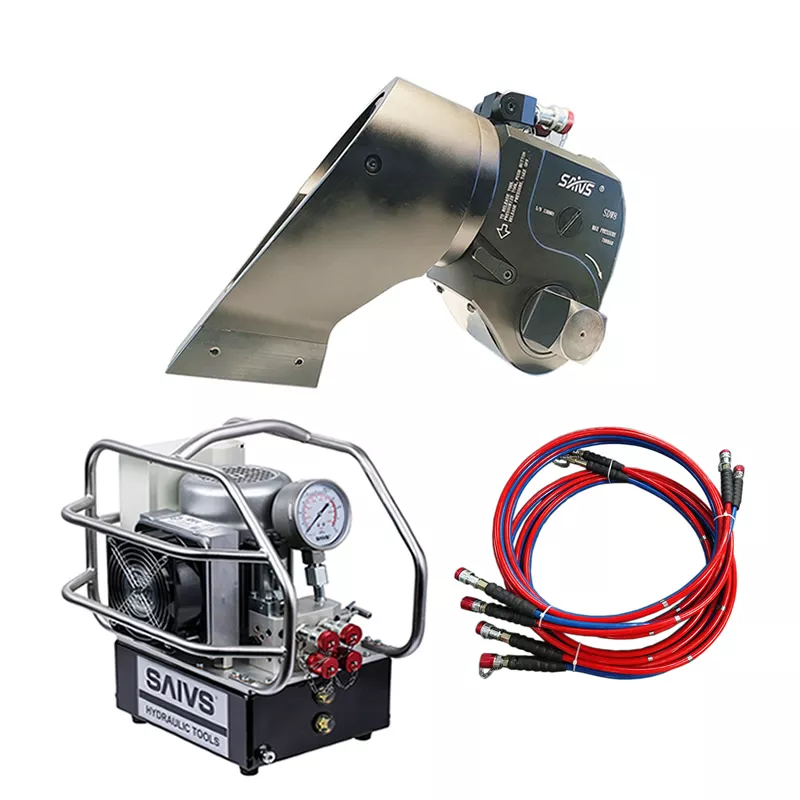Hydraulic Wrench Calibration:4 Methods
Hydraulic torque wrenches need to be calibrated for torque accuracy after a year or thousands of uses.
SAIVS will now detail several calibration solutions for hydraulic wrenches.
Calibration via hydraulic wrench torque calibration equipment
If you frequently use a large quantity of Hydraulic Wrenches, purchasing a torque calibration device
is the most cost-effective and labor-saving option. Torque calibration equipment can be obtained from
the hydraulic wrench manufacturer since each brand of wrench may have slight differences.
It is recommended to use the corresponding torque calibration equipment provided by the original factory.
Calibration by a third-party testing agency
Calibration and testing of hydraulic wrenches by a third-party professional testing organization
is considered one of the most reliable methods. These testing institutions typically provide national-level
testing certificates, which are highly trustworthy. In China, for example, Beijing 304 (under China Aerospace Corporation)
and Shanghai 704 (under CSSC) are professional third-party testing institutions.
The disadvantage of this method is that the cost of detection is determined by the number of hydraulic
wrenches being tested, and the torque value of different wrenches also affects the detection cost.
Hydraulic wrenches with higher torque require larger torque sensors, which increases the cost.
Additionally, the detection period is relatively long.
Detection by manual calculation
To manually calculate the calibration of hydraulic torque wrenches, you will need a few key
components and follow specific steps. Here's a general guideline:
1. Preparation:
- Ensure the Hydraulic Torque Wrench is clean and in proper working condition.
- Familiarize yourself with the manufacturer's specifications and recommended calibration procedures.
- Set up the torque tester or calibration equipment according to its instructions.
2. Zero Calibration:
- Attach the hydraulic Torque Wrench to the torque tester or calibration equipment.
- Set the torque tester or calibration equipment to zero or the lowest torque value.
- Apply a controlled amount of torque to the wrench, usually in the counterclockwise direction,
until the tester indicates no torque.
3. Calibration Points:
- Determine the specific torque values at which you want to calibrate the wrench.
These points should cover the range of torque values you typically use.
- Follow the manufacturer's guidelines or industry standards for selecting calibration points.
4. Calibration Procedure:
- Apply the desired torque value to the hydraulic torque wrench using the torque tester or calibration equipment.
- Note the actual torque value displayed on the tester or calibration equipment.
- Compare the actual torque value with the target torque value and record any deviations.
It's important to note that manual calibration of hydraulic torque wrenches requires technical expertise and precision.
If you are unsure or lack experience, it is recommended to consult a professional calibration service or
contact the manufacturer for assistance.The calculation formula is
(standard torque value – actual output torque value of hydraulic wrench) / standard torque value*100%≤3%
The disadvantage of the above method is that it cannot achieve very accurate calculations,
and this method is only suitable for projects that do not require high torque accuracy.
Calibrating Hydraulic Torque Wrenches Using a Smart Socket
The Smart Socket is an advanced torque tool that incorporates a specialized socket with a built-in sensor.
This sensor accurately detects the final torque applied to a bolt, enabling precise torque accuracy detection for hydraulic wrenches.
The smart socket features three intuitive buttons that allow users to select various functions,
which are displayed on the screen. Its outer dimensions are comparable to those of a standard socket,
allowing it to seamlessly replace existing sockets while adding the capability of torque precision detection and control.
These features make it an ideal tool for both bolt torque detection and torque tool calibration.
Additionally, the smart socket is equipped with built-in Bluetooth technology, enabling real-time data to be
transmitted and viewed on a smartphone or tablet through Bluetooth connectivity.
It's important to note that one potential drawback of this method is the requirement for a custom socket,
which may incur additional costs compared to standard sockets.
Why Choose SAIVS™ as Your Supplier?
With 20 years of industry experience, SAIVS is a leading Chinese manufacturer of high-quality tools, offering competitive pricing and excellent customer service.We pride ourselves on exceptional quality control, extensive experience, and comprehensive after-sales service.
